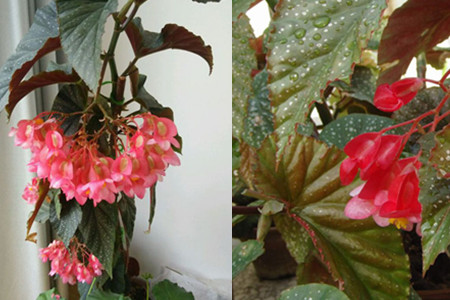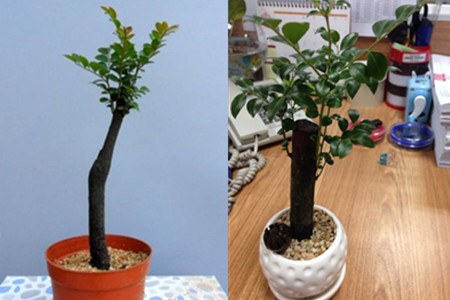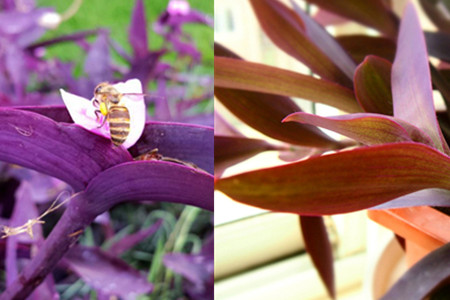New plants are planted in three steps by cutting method of bamboo crabapple

When it comes to which plants can be placed in the house and can produce delicate and beautiful flowers, many friends should think of bamboo crabapple. This is a very common plant that can be seen in many people's homes or companies because it is small and can be planted in smaller pots and does not take up much space on the table. In addition, the flowers of this plant are also very beautiful when they bloom. it not only has delicate colors, but also has a lot of them.
As for what kind of way this plant propagates, it is no longer so detailed here. Let's focus on a more common method, that is, cutting. So, what are the specific operations for the cutting of this plant?
1. Select the mother plant
Friends should choose a more robust bamboo crabapple in advance, and be careful not to have any symptoms. In addition, friends can not choose those old branches, because this kind of branches will not have too strong vitality, should choose those more tender branches.
2. Pruning
Boil the scissors in a pot for about a quarter of an hour. After drying, you can prune the branches. Friends should try to choose a place about 15 centimeters from the top of the branch to cut it off, so that they can be sure to let it survive.
3. Cuttage
Insert the cut branches into the prepared soil, be careful not to insert too much, about five centimeters will be enough. And when mixing soil, friends should also pay attention, can add more vermiculite into it, so that it will not be easy to rot roots, and then add some peat, wait for about two weeks to grow fine roots.
Generally speaking, the cutting of this plant is still quite complex. I hope friends can learn it soon.
See also May Bamboo Begonia Cuttage season
Since ancient times, there have been countless poems praising begonia. Begonia, a plant that enjoys both elegance and popularity, has become the favor of countless people. As the ancients said, "the willow waist is timid and the flowers are weak, reflecting the swing courtyard in red." it can be seen that crabapple flowers are an excellent choice for most people to decorate the courtyard and enhance the atmosphere. As a popular bamboo crabapple, when it ushered in the midsummer of May, it means that it is a good time for cutting, what kind of knowledge is there? Let the editor make a perfect answer for you today!
Growth habit
Warm in winter and cool in summer: it grows rapidly in a warm environment, with luxuriant stems and leaves and bright colors. The suitable temperature for growth is 19-24 ℃, and the winter temperature is not lower than 10 ℃, otherwise the leaves are easy to freeze, but the rhizome is more cold-tolerant.
Half-yin and half-yang light: begonia is sensitive to light. It is generally suitable for growth in morning light and scattered light, and it is easy to cause leaf burns in strong light. The suitable light intensity of rhizome is 200-300lx. In addition, the response to photoperiod is also very obvious. Under the condition of short day light and night temperature of 21 ℃, the flowering period was delayed obviously.
Loose and fertile soil: wild species have good drainage and rotten leaf soil under forests or in rock crevices, which is extremely beneficial to root growth and development. Compost soil, rotten leaf soil and charcoal soil are commonly used in potted begonia. Alkaline or clayey, easily hardened soil as a pot use, is not conducive to the growth of new roots, resulting in short stems and leaves, dim color, easy to cause yellow wilt. It is suitable to grow in neutral soil with pH 6.5-7.5.
Pest control
Leaf spot disease
Bacterial disease symptoms of leaf spot caused by Alternaria: begonia is very easy to be infected by this strain, but many producers do not pay enough attention to it and do not think it is a disease. because leaf edge necrosis and leaf spots are the most common, this has happened in almost all types of begonia.
Control method: the best way to control the disease is to try to avoid infection at the beginning of cutting propagation, and to destroy the diseased plant in time after discovering the diseased plant; in addition, to minimize the use of irrigation at the top of the plant, this will also inhibit the occurrence and spread of the disease; slightly reducing the concentration of feed can also reduce the occurrence of the disease.
Symptoms of leaf spot disease of Begonia caused by lacquer spot fungus: the disease generally appears on the edge, tip and vein of the damaged leaf. The necrotic area is dark brown and then watery. The diagnosis is that the lower leaf is often an irregularly shaped spore group, with a black center but a white edge.
Control methods: spraying fungicides, reducing plant injury and reducing fertilizer to a reasonable level can reduce the disease.
Grey mold disease
Fungal diseases, Botrytis cinerea symptoms caused by Botrytis cinerea: Begonia leaf Botrytis cinerea often occurs in the lower part of the plant, especially in the place where the rhizome is in contact with the substrate, the disease spot infiltrated by water will soon spread to the whole leaf and the whole plant, and the affected area shows necrotic spots and gradually changes from brown to black. When the temperature is low at night, the temperature is high and the humidity is high during the day, the growth of pathogenic spores is accelerated, and gray-green mildew grows on the damaged leaves.
Control method: controlling the spread of Botrytis cinerea fungi in winter months has become an important part of cultivation management, and the important way to reduce ash occurrence and diffusion is to accelerate the drying of leaves and reduce the air humidity in the greenhouse.
Root rot disease
Symptoms of root rot of begonia caused by Pythium: after infection with this pathogen, the root system of cuttings is weak and the leaves turn yellow. The diagnosis is that black paste appears in the stems and roots, which can spread all the way from the base of the cuttings to the parts of the stems and leaves. Root and stem rot often occurs in pieces, and through the planting bed, it is easy to transmit germs to healthy cuttings.
Control method: first of all, control from the source, that is, using sterile materials from the beginning of reproduction, disinfecting the upper basin substrate and planting bed before and after planting with fungicides can well control the root rot caused by Rhizopus. In addition, the amount of water irrigation should be reduced as much as possible to reduce the occurrence of root rot and promote root growth.
Cataplexy
Symptoms of sudden collapse caused by Rhizoctonia solani: a brown mildew attached to the disease after onset. Mildew can extend from the basin soil to the plant. If you look closely, you can see that this is due to the mildew from the rhizome of the plant. Standing withered silk is often reddish brown in color and looks like a spider web.
Control method: the quenching disease caused by Rhizoctonia solani can be controlled by spraying different fungicides, most of which are irrigated by soil.
Fusarium wilt
Phellodendron mandshurica (Thunb.)
Southern Fusarium wilt caused by white silk pathogen: White silk disease can infect part of the plant, but it is most easily observed in leaves and stems. At first, there are watery spots where the stem segments come into contact with the medium. in another symptom, a fan-shaped mildew grows on the leaf surface or matrix, which is white at first and then turns dark brown as it develops. Especially in the warm if the plant is infected, it is easy to cause cuttings to rot.
Control method: all infected plants and containers should be removed from the planting area as soon as possible and the plants should be destroyed. At present, there is no effective potion for Baijuan.
I. the past life and present life of bamboo crabapple
Bamboo crabapple, also known as French begonia and safflower begonia, is a kind of plant suitable for potted ornamental plants, which is named because its stem looks like bamboo. The whole plant is hairless, the stem is erect, and the stem nodes are as thick as bamboo knots, which are mostly placed on the windowsill and courtyard, such as fine management, which can be as high as 1 meter, graceful and graceful when the flowers bloom, and the wind is moving. Because its flower appearance is chic and unrestrained and blooming like brocade, it has been planted with famous flowers such as magnolia and peonies since ancient times, thus forming the beauty of "Yutang wealth".
2. Cutting method of bamboo crabapple.
The most common propagation method of bamboo crabapple is cutting, and spring and autumn are the most suitable periods. In May, with the prevalence of plum rain and abundant sunshine, it is a good time to cut bamboo crabapple. The specific operation method is to select the green and robust terminal bud, which is about 4-7 stem nodes in length. After the treatment of the lower part of the leaves, the top 2-4 leaves are cut in half and cut in vermiculite or perlite to keep the soil with about 1 inch of soil moisture, moist surrounding air and moderate light intensity. It can take root in nearly one month, and after the root group is developed and vigorous, it is transplanted into a new basin, and then as long as the shade is timely. Pay attention to ventilation when muggy, careful maintenance can wait for flowering.
Third, this management allows bamboo begonia to blossom for ten months.
The sandy soil with slight acid decay is the best.
The adaptability of bamboo begonia is stronger than other varieties, especially in slightly acidic, humus-rich and loose soil. The number of soil change is moderate, and the soil change is controlled in 1-2 years in spring.
Cool environment to improve maintenance
Bamboo crabapple is a "beauty" who is afraid of the cold, and she also avoids extreme heat in summer. After the height of summer, bamboo crabapple should be moved to the shade of trees, so that it can not only ensure ventilation, but also allow this "crabapple beauty" to accept the natural conservation of scattered light in the morning, so as to avoid the unexpected occurrence of its dormancy strike.
When pruning is going on in early spring
Early spring is not only the best time to change soil for bamboo crabapple, but also a good time for pruning. When pruning, remember to observe as a whole, considering the plant type of bamboo begonia, ensuring that the surrounding skeleton is scattered, which is conducive to daylighting, ventilation, moisture absorption, etc., so that the trimmed structure is compact and the lines are very beautiful. Then, on this basis, the sprouting head is capped uninterruptedly, so as to stimulate the new branches to grow flower buds and prevent the plant type from being loose and out of shape.
How to Culture Bamboo Begonia
Bamboo crabapple is a perennial shrub plant, which is suitable for home culture and ornamental bamboo crabapple. The flowers of bamboo crabapple are more colorful and beautiful, and they blossom more in summer and autumn. Next, let's take a look at the culture method of bamboo begonia.
Culture methods of Bamboo Begonia
Propagation method: the propagation of bamboo crabapple is mainly based on cutting, which can be divided into two types: water cutting and split propagation. When cutting, select the well-growing top twigs to cut 3 to 4 segments about 10 cm to 15 cm long, and the incision at the lower end should be 0.5 cm at the lowest section, and then insert it into the river sand seedbed. All the leaves in the soil should be removed, and the upper 2 or 3 leaves can be retained.
Watering management: bamboo crabapple belongs to shallow root plant, likes semi-shade, mild and humid environment, its best growth temperature is between 15 and 25 degrees, drought resistance is strong, but it is afraid of waterlogging, so watering of bamboo crabapple should pay attention to dry and wet. It is best to keep the basin soil moist. In the midsummer season, it is necessary to spray water on the leaf surface and the ground, and increasing the humidity of the air will be beneficial to its growth.
Fertilization management: the fertilization of bamboo crabapple should be carried out when the basin soil is dry, and watering after fertilization can ensure that it is fully absorbed by the plant. Bamboo crabapple should avoid applying large fertilizer when it is newly turned over and its stems and leaves are not flourishing. In the peak period of growth, it is guaranteed to apply dilute liquid fertilizer every 10 to 15 days.
Light management: bamboo crabapple likes sufficient scattered light, but too much light will lead to the dry tip and scorched edge of the leaves, resulting in yellowing or even falling leaves. In the hot summer, it is best to put it under a cool, ventilated, shady scaffolding or on the north balcony to receive scattered light. If it is placed in the dark for a long time, it will lead to insufficient light, yellow leaves and, in severe cases, plant death.
Pruning plants: bamboo crabapple because the plant is tall, perennial plants may grow too high and lead to the lower part of the stem flowers and leaves fall off, resulting in the plant shape is not beautiful and affect the ornamental effect, so it needs to be pruned to maintain its good shape. Plant pruning can be carried out in combination with changing pots in spring, which can help plants sprout new branches and blossom more.
Pest control: excessively high temperature and humid weather in summer will lead to diseases and insect pests of bamboo begonia. For the prevention and control of diseases and insect pests, on the one hand, we should strengthen ventilation and light, do not allow a large amount of stagnant water in the basin, and ensure that fungicides are sprayed every 15 days, such as methyl thiophanate, carbendazim and so on, which can prevent the occurrence of diseases. If red spiders are found to be harmful, 1500 times of dicofol can be sprayed, and a small amount of shell insects can be brushed off manually.
- Prev

Are lobular red sandalwood bonsai true? teach you how to tell the true and false of valuable potted plants.
Lobular red sandalwood bonsai as an ornamental bonsai price remains high, there is an inch of sandalwood gold on the market. Driven by huge interests, there are a lot of fake goods in the market. Many vendors pretend to be lobular red sandalwood with black bone tea. How to tell whether the lobular red sandalwood bonsai is true or false?
- Next

How to grow fresh plants by cutting in three steps
Purple orchid, also known as color leaf orchid, is a plant of Liliaceae. Purple orchid is a perennial herb. It is suitable for hanging potted foliage flowers, suitable for viewing in hanging pots, and conducive to fresh indoor air. In recent years, it is also used in flower beds.
Related
- Fuxing push coffee new agricultural production and marketing class: lack of small-scale processing plants
- Jujube rice field leisure farm deep ploughing Yilan for five years to create a space for organic food and play
- Nongyu Farm-A trial of organic papaya for brave women with advanced technology
- Four points for attention in the prevention and control of diseases and insect pests of edible fungi
- How to add nutrient solution to Edible Fungi
- Is there any good way to control edible fungus mites?
- Open Inoculation Technology of Edible Fungi
- Is there any clever way to use fertilizer for edible fungus in winter?
- What agents are used to kill the pathogens of edible fungi in the mushroom shed?
- Rapid drying of Edible Fungi

